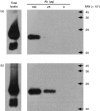Antibody cross-linking of human CD9 and the high-affinity immunoglobulin E receptor stimulates secretion from transfected rat basophilic leukaemia cells
- PMID: 10792502
- PMCID: PMC2327194
- DOI: 10.1046/j.1365-2567.2000.00992.x
Antibody cross-linking of human CD9 and the high-affinity immunoglobulin E receptor stimulates secretion from transfected rat basophilic leukaemia cells
Abstract
Previous studies have shown that antibody cross-linking of the tetraspanin protein CD9 stimulates the degranulation of platelets and eosinophils, although the mechanism of activation is unclear. In this work we transfected human CD9 into the rat basophilic leukaemia (RBL-2H3) cell line and studied the stimulation of secretion from these cells in response to a panel of anti-CD9 antibodies. Intact immunoglobulin G1 (IgG1) antibodies activated transfected cells whereas F(ab')2 fragments of antibody and an intact IgG2a did not. Stimulation of secretion was inhibited by co-incubation with monomer murine immunoglobulin E (IgE) but not with an IgG1 isotype control, indicating that the response involves the endogenous high-affinity IgE receptor (FcepsilonRI). The anti-CD9 antibody activation curve was biphasic, and supraoptimal antibody concentrations stimulated little or no degranulation, indicating that multivalent binding of human CD9 molecules is necessary for the formation of an active complex with rat FcepsilonRI. Immunoprecipitation of FcepsilonRI under mild detergent conditions co-precipitated CD9, suggesting the presence of pre-existing complexes of CD9 and FcepsilonRI that could be activated by antibody cross-linking. These data are further evidence that tetraspanins are involved in FcepsilonRI signalling and may reflect the participation of tetraspanins in the formation of complexes with other membrane proteins that use components of Fc receptors for signal transduction.
Figures




References
-
- Wright MD, Tomlinson MG. The ins and outs of the transmembrane-4 superfamily. Immunol Today. 1994;15:588. - PubMed
-
- RubeIstein E, Lenaour F, Lagaudriere-gesbert C, Billared M, Conjeaud H, Boucheix C. CD9, CD63, CD81, and CD82 are components of a surface tetraspan network connected to HLA-DR and VLA integrins. Eur J Immunol. 1996;26:2657. - PubMed
-
- Hemler ME, Mannion BA, Berditchevski F. Association of TM4SF proteins with integrins – relevance to cancer. Biochim Biophys Acta. 1996;1287:67. - PubMed
-
- Maecker HT, Todd SC, Levy S. The tetraspanin superfamily: molecular facilitators. FASEB J. 1997;11:428. - PubMed
-
- Jones PH, Bishop LA, Watt FM. Functional significance of CD9 association with beta (1) integrins in human epidermal keratinocytes. Cell Adhesion Commun. 1996;4:297. - PubMed
Publication types
MeSH terms
Substances
LinkOut - more resources
Full Text Sources
Other Literature Sources
Molecular Biology Databases

